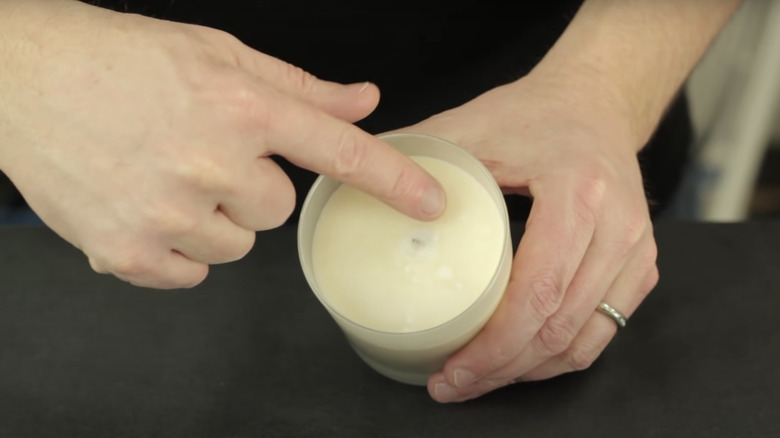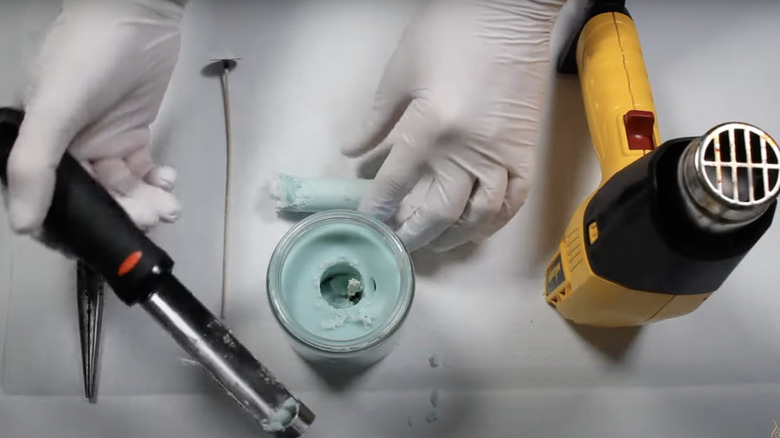3 Ways To Salvage A Broken Candle Wick And Keep It Working
We may receive a commission on purchases made from links.
For so many of us, candles have become part of our routine for a relaxing night. They're in almost every room of the house from the living room to the dining room to the bathroom. Lighting a candle, hearing the soft crackle of the burning wick, and smelling the sweet or musky aroma can help replace anxiety with a calm feeling. According to candlemakers at The Melt, the illumination of the candle's flame is the main reason relaxation ensues. When the soft light reaches our brain, we associate it with calmness, and our body starts to settle down.
Of course, when the candle's wick breaks or gets too short to light, it can put a dent in your nighttime routine, preventing that relaxing night. A wick might stop working due to how it's being burned, claims Brooklyn Candle Studio. If the candle isn't burning evenly, meaning there's wax on the sides of the container, it can damage the wick, they explain. Alternatively, if the wick is trimmed too short, or if you have not been trimming it, there could be damage from carbon buildup. We know you probably have some candles that need to be saved, so we put together three easy ways to bring your candle back to life.
Dig out a buried wick
There are times when the candle wick will appear broken, but it isn't. Instead, it's buried under a layer of wax. Sometimes it can be a manufacturer issue where it's a defective candle that won't burn, which you should return or exchange. On the other hand, if the wick hasn't been adequately trimmed, it'll start to bend, and the wax will melt over it, say the candle pros at Homesick. Provided you can still light the wick, you can allow it to melt for 20 minutes, after which the wick can be pulled out effortlessly. Once the wax has melted down, extinguish the flame, spill out the melted wax onto a plate, and carefully lift the wick with tweezers.
Since the wick is still hot, it can be prone to breaking, causing it to become even shorter. To prevent this from happening, Homesick suggests propping up the wick, which you can do with a clothespin. Then, once the wax has cooled, trim it down to about ¼ inch from the wax surface to restart the process and prevent the problem from happening again.
Remove and replace the entire wick
If it turns out that the candle wick isn't buried and it's actually broken, replacing the entire wick will make the candle new again. As Candleers suggests, you should remove the whole wick and wick sticker before securing the new one. Before you start, you'll need a few materials, such as an apple core tool, a heat gun, a clothespin, a new wick, and a wick sticker.
Use the apple core device to make a hole around the wax by pushing it down to the bottom of the container, then pull out the entire wick. Once the wick is out, Candleers suggests cleaning out the center of the candle before placing the new wick with the wick sticker into place, making sure it sticks to the bottom. Then, fill the hole with wax, melting it as you go with the heat gun. Repeat until all the wax has completely filled the space. Let the wax cool, and clip the clothespin to the wick to prevent it from being buried. After everything has cooled and solidified, remove the clothespin and trim the wick.
Taking care of the fixed wick
Replacing the wick is easy, but maintaining its life span can be challenging. It's best to keep your candles in good condition to get the most use out of them and to be able to reuse the jars when they're done. GoodLight Candles suggests trimming the wick of a candle before ever lighting it to prevent the leftover ash from falling into the wax. Giving the candle a quick wipe with a paper towel or cloth will remove any dust from a candle without a lid. In addition, candles burn brighter and longer when you keep the wick trimmed. Otherwise, it will smoke when it gets lit and cause a foul smell that'll obscure the candle's intended scent. You can buy special wick trimmers that catch the cut wick better than scissors.
Knowing how long you'll be burning the candle is crucial for continual use because it's possible to leave a candle burning for longer than we should, or to burn it for too short of a time, adds GoodLight Candles. Ideally, a candle should burn no more than four hours. If you don't want it to be lit for very long, burn the candle at least until the top layer is completely melted to maintain it evenly. Tunneling can occur if the wick isn't burned for at least two hours, which will bury the wick. Before relighting it, let a couple of hours pass to let the wax harden.



